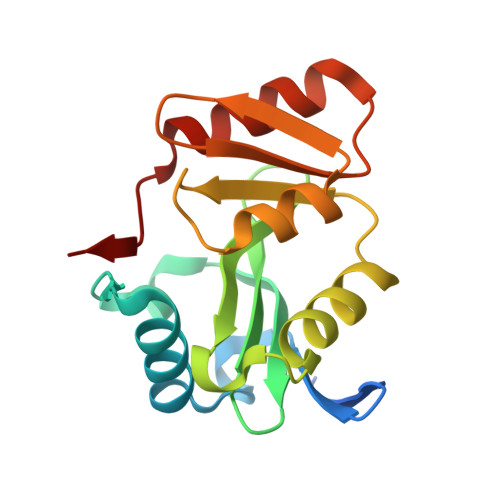Structures of the N-acetyltransferase domain of Xylella fastidiosaN-acetyl-L-glutamate synthase/kinase with and without a His tag bound to N-acetyl-L-glutamate.
Zhao, G., Jin, Z., Allewell, N.M., Tuchman, M., Shi, D.(2015) Acta Crystallogr F Struct Biol Commun 71: 86-95
- PubMed: 25615976
- DOI: https://doi.org/10.1107/S2053230X14026788
- Primary Citation of Related Structures:
4NEX, 4NF1 - PubMed Abstract:
Structures of the catalytic N-acetyltransferase (NAT) domain of the bifunctional N-acetyl-L-glutamate synthase/kinase (NAGS/K) from Xylella fastidiosa bound to N-acetyl-L-glutamate (NAG) with and without an N-terminal His tag have been solved and refined at 1.7 and 1.4 Å resolution, respectively. The NAT domain with an N-terminal His tag crystallized in space group P4(1)2(1)2, with unit-cell parameters a=b=51.72, c=242.31 Å. Two subunits form a molecular dimer in the asymmetric unit, which contains ∼41% solvent. The NAT domain without an N-terminal His tag crystallized in space group P21, with unit-cell parameters a=63.48, b=122.34, c=75.88 Å, β=107.6°. Eight subunits, which form four molecular dimers, were identified in the asymmetric unit, which contains ∼38% solvent. The structures with and without the N-terminal His tag provide an opportunity to evaluate how the His tag affects structure and function. Furthermore, multiple subunits in different packing environments allow an assessment of the plasticity of the NAG binding site, which might be relevant to substrate binding and product release. The dimeric structure of the X. fastidiosa N-acetytransferase (xfNAT) domain is very similar to that of human N-acetyltransferase (hNAT), reinforcing the notion that mammalian NAGS is evolutionally derived from bifunctional bacterial NAGS/K.
Organizational Affiliation:
Center for Genetic Medicine Research and Department of Integrative Systems Biology, Children's National Medical Center, The George Washington University, Washington, DC 20010, USA.
















